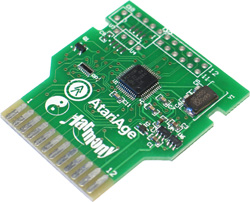What is a Melody Board?
 The Melody is a new circuit board developed by AtariAge that provides several advantages to the typical circuit boards used for new Atari 2600 homebrew games. Most notably, the Melody can be reprogramed without being removed from the cartridge, which allows us to offer a 50% trade-in credit on any games built with a Melody board. Additionally, should a newer version of a game become available, your Melody-based cartridge can be upgraded for free--you just pay shipping!
The Melody is a new circuit board developed by AtariAge that provides several advantages to the typical circuit boards used for new Atari 2600 homebrew games. Most notably, the Melody can be reprogramed without being removed from the cartridge, which allows us to offer a 50% trade-in credit on any games built with a Melody board. Additionally, should a newer version of a game become available, your Melody-based cartridge can be upgraded for free--you just pay shipping!Melody is based on the same technology used by the even more advanced Harmony Cartridge. In fact, a Melody board is basically half of a Harmony Cartridge! It features an advanced, on-board processor and Flash-based memory that can be reprogrammed time and time again.
Advantages of the Melody board:
 Uses all new, surface-mount components. Before the Melody, most 2600 homebrew games used refurbished EPROMs, many of which are 25+ years old. As these parts age, there's always the increased possibility of failure. According to the chip manufacturer, the Flash memory on the Melody board has a guaranteed minimum lifetime of 20 years. We expect that the typical lifetime is many times longer.
Uses all new, surface-mount components. Before the Melody, most 2600 homebrew games used refurbished EPROMs, many of which are 25+ years old. As these parts age, there's always the increased possibility of failure. According to the chip manufacturer, the Flash memory on the Melody board has a guaranteed minimum lifetime of 20 years. We expect that the typical lifetime is many times longer.- Melody boards can be reprogrammed without having to open the cartridge. Thus, you can "recycle" your Melody-based game and get a significant 50% credit towards a new game, or, if an upgrade for the game becomes available you can get the latest version by sending the cartridge to us and paying return shipping.
- The Melody has on-board RAM and supports every known Atari 2600 bankswitching method up to 32K in size. This includes SARA-based (Superchip) games and all the unique bankswitching schemes developed by third-party 2600 game developers. This gives homebrew authors more flexibility in developing new games down the road.
- The Melody has increased compatibility with the wide variety of 2600-compatible game systems in existence. It's not uncommon to run into systems that have problems playing a particular Atari 2600 homebrew game for one reason or another (this happens often with the 7800). The Melody board virtually eliminates this problem.
- We can ship Melody-based games more quickly than games built with traditional boards since we do not need to program the parts and hand solder components to the circuit board.
How do I identify a Melody-based game?
You can use a small flathead screwdriver or other small implement to push open the dust-cover mechanism of an Atari 2600 cartridge until the circuit board is revealed. Melody-based boards will have the word "Harmony" visible on one side of the circuit board, as shown in the picture below:
Look for the "Harmony" logo near the bottom of the circuit board.
Homebrew Author Benefits
As mentioned above, the Melody board supports all known bankswitching methods. In the past, most homebrew games larger than 4K were limited to using Atari's standard F8 (8K), F6 (16K), and F4 (32K) bankswitching methods. Not only does the Melody open the door for additional bankswitching methods developed by Atari and third-party companies "back in the day", but it also allows for development of new, custom bankswitch methods. The Melody also has 8K of on-board RAM, a huge asset given the Atari 2600's stock 128 bytes of memory.Besides additional ROM and RAM, one of the later advancements in 2600 bankswitch hardware was the addition of a coprocessor. David Crane created the DPC coprocessor, which was used to great effect in the game Pitfall II: Lost Caverns. The DPC coprocessor sped up common display kernel routines, and generated the values to play 3 voice music via TIA. The Melody's onboard processor is fast enough to emulate DPC, as well as custom coprocessor designs such as DPC+ which is used in homebrew games like Scramble and Stay Frosty 2. DPC+ builds upon DPC by allowing for larger games, even faster display kernel routines, better sounding 3 voice music, and even the optional ability to offload game logic to the Melody's faster processor.
Additionally, Melody boards can be built with a 128K Flash chip, replacing the Melody's standard 32K of Flash memory. And if 8K of RAM isn't enough for you, up to 64K of RAM can be added instead. This allows for a Melody board containing 128K of Flash memory and 64K of RAM. And if that's not enough, the Melody can be fitted with an optional EEPROM chip up to 4MB in size!
If you're interested in developing a homebrew game using a unique bankswitching method, or would like to explore using Melody boards with additional Flash and/or RAM, please drop us a line.
